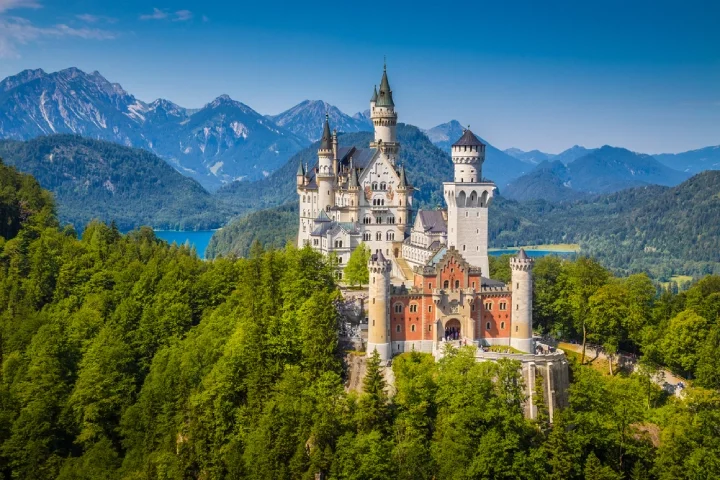
Here’s our list of the 10 biggest castles in the world.
Everyone has dreamt of living in a castle at least once, as they are symbols of fairytales, royalty and wonderment.
Castles can be unimaginably big, with hundreds of rooms and complex architectural features. Spear’s has collated a list of the ten largest castles in the world, from Portugal to Austria and Slovakia.
Prague Castle, Czech Republic

Showcasing a blend of Gothic, Romanesque and almost every other architectural style that the last millennium could dish out, Prague Castle, in the capital of the Czech Republic, is believed to have begun as a fortification built by Prince Bořivoj and his son Spytihněv of the Premyslid dynasty around 880.
Declared a UNESCO World Heritage site in 1992, Prague Castle underwent renovation under Slovenian architect Josip Plečnik between 1918 and 1938. Covering a total surface area of around 18 acres (66,761 sq m), Prague Castle is in the Guinness Book of Records for being the biggest ancient castle in the world.
Malbork Castle, Poland

A UNESCO World Heritage Site since 1997, Malbork Castle lays claim to the title of being the biggest castle in the world at 143,591 square meters. This giant is situated in the town of Malbork, Poland, just an hour’s train journey from Gdansk. Built by Teutonic knights in 1274 as a fortified monastery, the castle/convent was used by these warrior monks as their headquarters while conducting crusades against pagans in the Baltic territories.
Although completed in 1406, the castle was expanded quite often, housing about 3,000 Teutonic knights at one time. After the knights were driven back to Königsburg in 1466, Malbork Castle came under the rule of the Polish monarchy. More than half of it was destroyed during World War II when Germany occupied Poland but has since been restored with the final restoration work finishing in 2016.
Palácio da Pena, Portugal

As vibrant as a swashbuckling pirate’s attire, Portugal’s multi-hued Palácio da Pena primarily began as a chapel for Our Lady of Pena in the Middle Ages built on a hill, above the town of Sintra. In 1493, a monastery was constructed by the order of King Manuel I, but in 1838 King Ferdinand II acquired the monastery and the surrounding areas, and built himself a castle (1842-1847) that today proudly stands as Palácio da Pena.
A reflection of the 19th-century romanticism of Portugal, the castle’s eclectic architecture is a combination of Manueline, Gothic and Moorish styles. Declared a World Heritage site by UNESCO in 1995, the castle covers 2,337 acres with nearly 500 acres comprising forest terrain and verdant gardens. The Pena Palace was declared a national monument after the 1910 Republican Revolution and converted into a museum.
Alcázar of Segovia, Spain

Originating from the Arabic word al qasr—meaning fortress—the Segovia Alcázar, in Castile and Léon, Spain was a fortress, to begin with. Built by the Morocco-based Berber Almoravid dynasty in the early 12th century, the fortress later became a royal palace than a military academy.
This 331-acre castle shows fairytale-like features and resembles a ship’s bow from an angle and was one of the inspirations for Walt Disney’s Cinderella Castle at Orlando. It was here in the Alcázar, during Spain’s golden era, that the famous Queen Isabella (the financier for Columbus’ quest for the New World) was crowned monarch in 1474. Although not the castle, the Old Town of Segovia and the Roman Aqueduct in it were declared UNESCO Heritage sites in 1985.
Windsor Castle, England

Built as a motte-and-bailey castle by William the Conqueror in the 11th century after the Norman Invasion of England to guard the western approach to London, Windsor Castle is said to be the largest occupied castle and the oldest royal residence in the world. It is also England’s largest castle.
The 13-acre castle holds one of the most beautiful churches in England in the form of St George’s Chapel (which is also the burial place of 10 monarchs of the UK), State Apartments that house some of the Royal Treasure, and a miniature marvel in the form of Queen Mary’s Doll House.
It was the royal family’s refuge during the Luftwaffe bombings of World War II and the castle also survived a fire in 1992. It used to be late Queen Elizabeth II’s favourite getaway within reach of Buckingham Palace.
Hohensalzburg Castle, Austria

Festung Hohensalzburg or Salzburg Castle was built in 1077 in the period of the Holy Roman Empire on the Festungsberg Mountain, by the Archbishops of Salzburg, Austria.
Looking down from a height of 506 metres, it is also one of the best-preserved castles in Europe and was made accessible to the public from 1892 onwards using the Festungsbahn, Salzburg’s funicular railway cable car (the oldest of its kind in the continent). Until 1960, before electricity took over, the cable cars were uniquely propelled towards the castle via a water pumping system called Tröpferlbahn or Droplet Railway. The Festungsbahn is so convenient for visitors that it ferries them right up to the castle.
Spis Castle, Slovakia

Located on a travertine hill, about 634 m above sea level, in the Spiš region of eastern Slovakia, Spiš Castle is one of the ten biggest in the world with an area spanning over 12 acres. Although the oldest recorded mention of the castle dates back to 1120, it was renovated in the first half of the 13th century with the main body fortified by stone walls to protect the palace from raiding Tartars. Spiš Castle was then completely rebuilt in the 15th century. The palace’s architectural style was Romanesque in the beginning but later rebuilt in Gothic fashion.
Spis Castle was declared a UNESCO World Heritage site in 1993 and it presently functions as a museum. Its Gothic magnificence has been used as film locations as seen in Dragonheart (1996) and The Last Legion (2006).
Château de Chambord, France

Originally a hunting lodge by French King Francois I in 1519, Château de Chambord went on to become the most majestic Renaissance castle in Loire-et-Cher (Loire Valley). It is said that the famous visionary and painter Leonardo Da Vinci was invited to the castle during its construction and thus could have had a say in its design. However, Italian architect Domenico da Cortona is mostly credited with being the architect of this spectacular structure.
Among the château’s architectural highlights is the spectacular double helix staircase that is the cynosure of all visiting eyes. Both spiral staircases do not meet anywhere in the three-floor ascent. Chambord Castle was declared a UNESCO World Heritage site in 1981.
Buda Castle, Hungary

With an area measuring over 11 acres, Hungary’s Buda Castle was built on Castle Hill (in the present city of Budapest) between 1247 and 1265 by King Bela IV for the safety of the citizens of Buda following a Mongol raid. From 1410 to 1437, Buda Castle was the main residence of Holy Roman Emperor Sigismund, during whose long reign it was considered the largest Gothic palace of the late Middle Ages.
After a lot of destruction to the old castle during the Ottoman era, the current palace that stands today was constructed between 1749 and 1769 and mostly reflects Baroque architecture. It was declared a UNESCO Heritage Site in 1987 and is currently home to the Budapest History Museum and the Hungarian National Gallery. Pop singer Katy Perry used the Castle’s courtyard as a setting for her 2010 music video of “Firework”.
Neuschwanstein Castle, Germany

Nestled in the Bavarian Alps, Neuschwanstein Castle (New Swan Stone or New Swan Castle about German composer Wagner’s character the Swan Knight) portrays the typical medieval castle right out of the pages of a fairytale.
The German castle was the brainchild of the reclusive King Ludwig II, who built it as a refuge for himself and also to honour his favourite composer Richard Wagner. Constructed through personal funding boosted by huge loans, he recruited stage designer Christian Jank to create the castle’s design, but the final castle construction was overseen by architect Eduard Riedel.
Construction began in 1869, but Ludwig himself never lived to see it completed and died in 1886 (the final towers were completed only in 1892). An architectural marvel of the Romanesque Revival style—although intended to be neo-Gothic originally—Neuschwanstein is one of the castles that inspired the 1950 Disney classic film Cinderella, Sleeping Beauty’s castle in Disneyland and has appeared in the 1963 Hollywood War classic The Great Escape.
More from Spear’s
10 of the World’s Must-See Museums
From Beaches to Bunkers: An Outdoor Life in Portugal’s Playground






